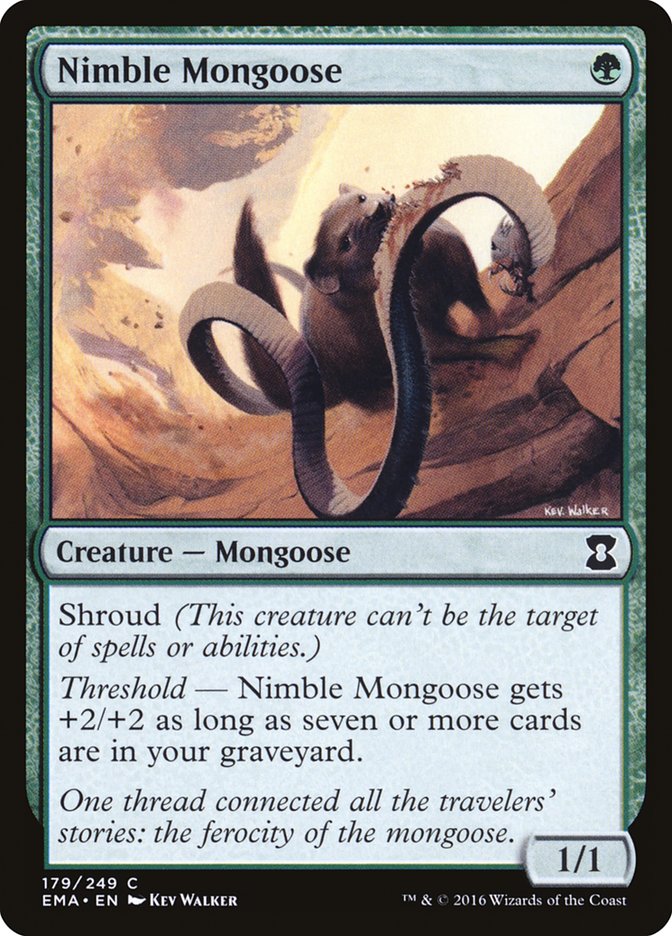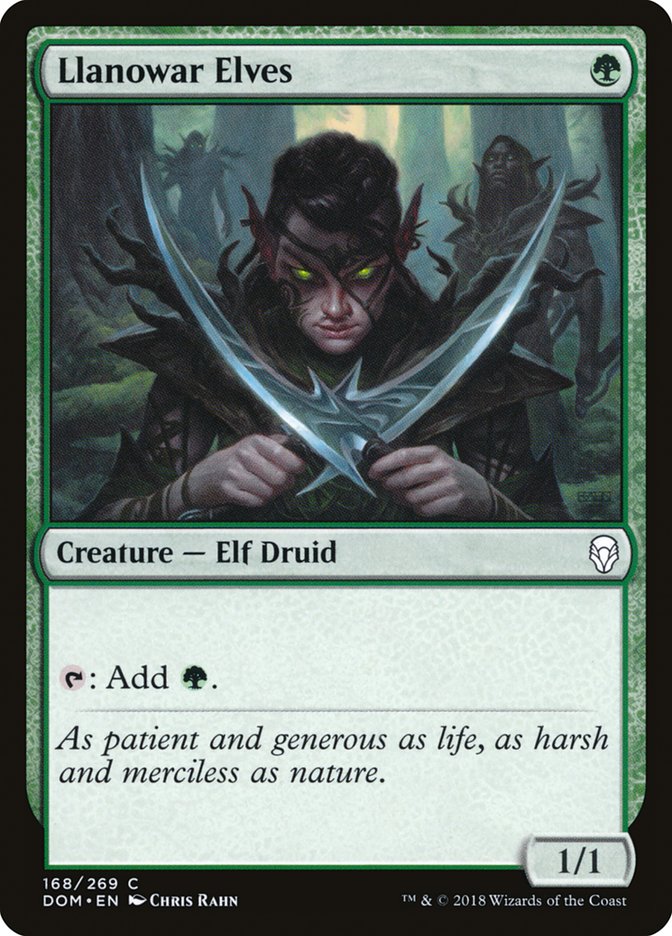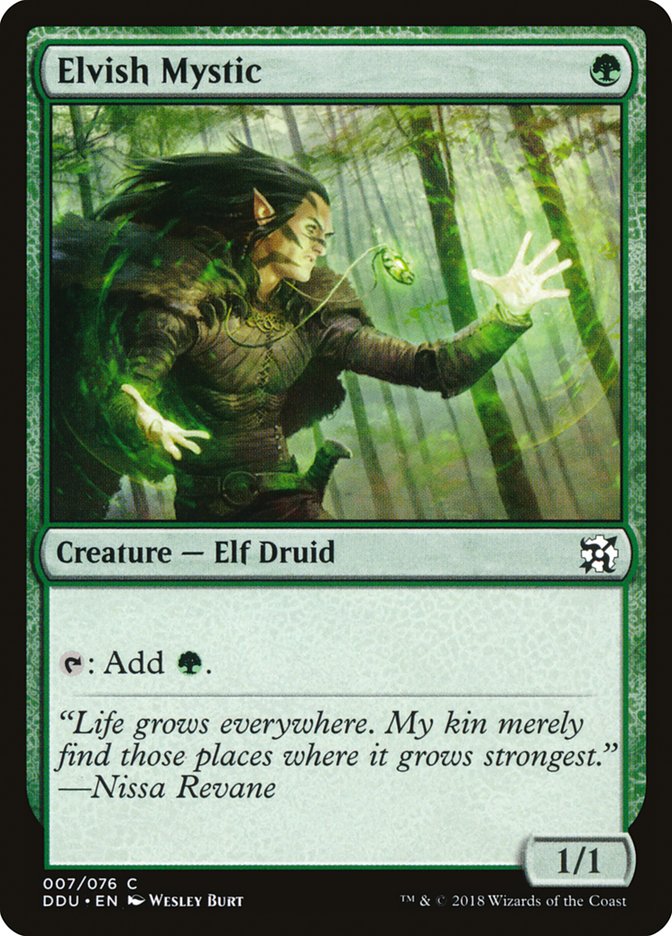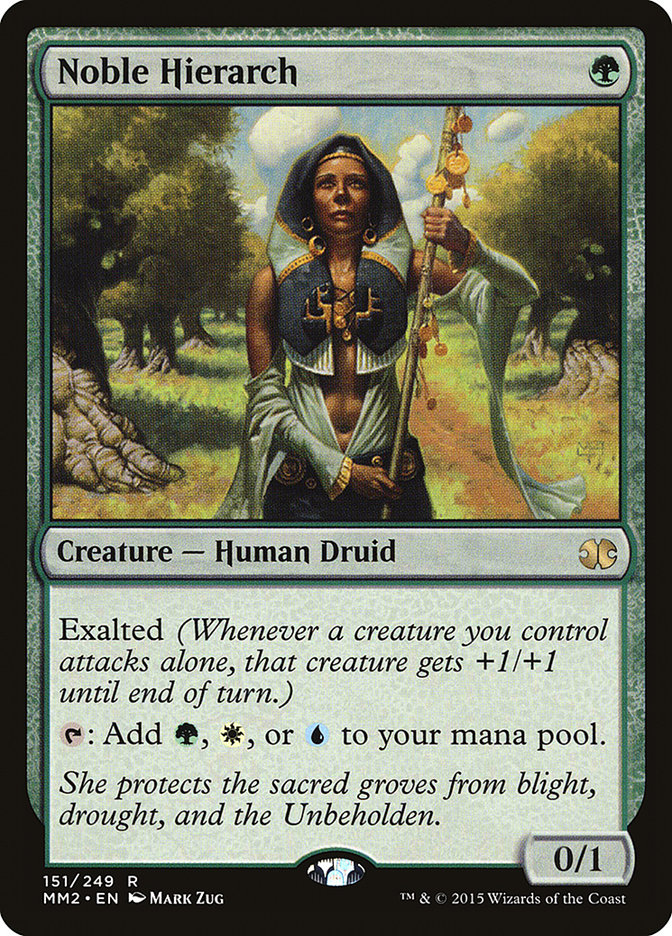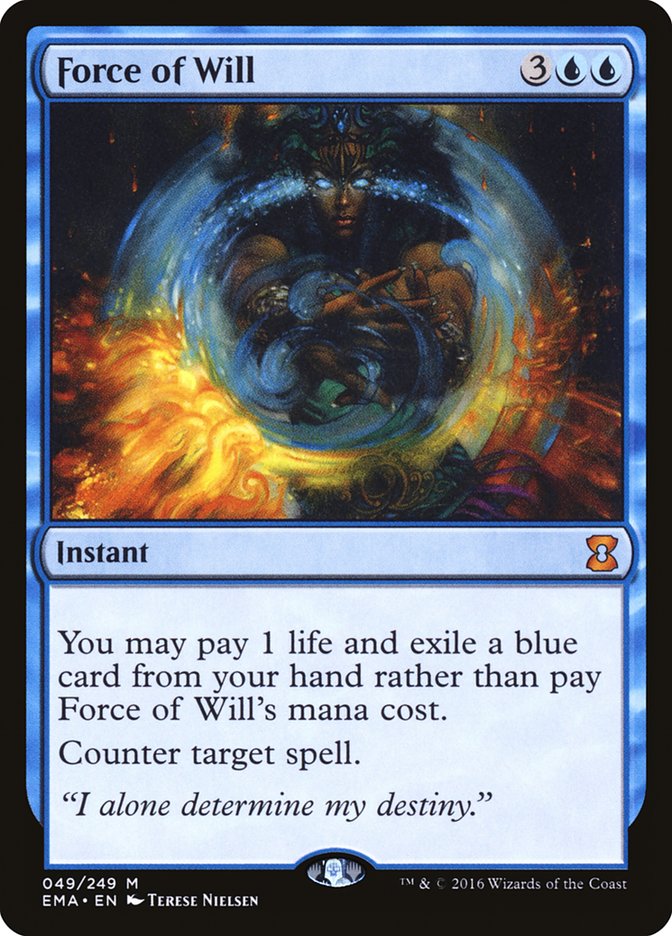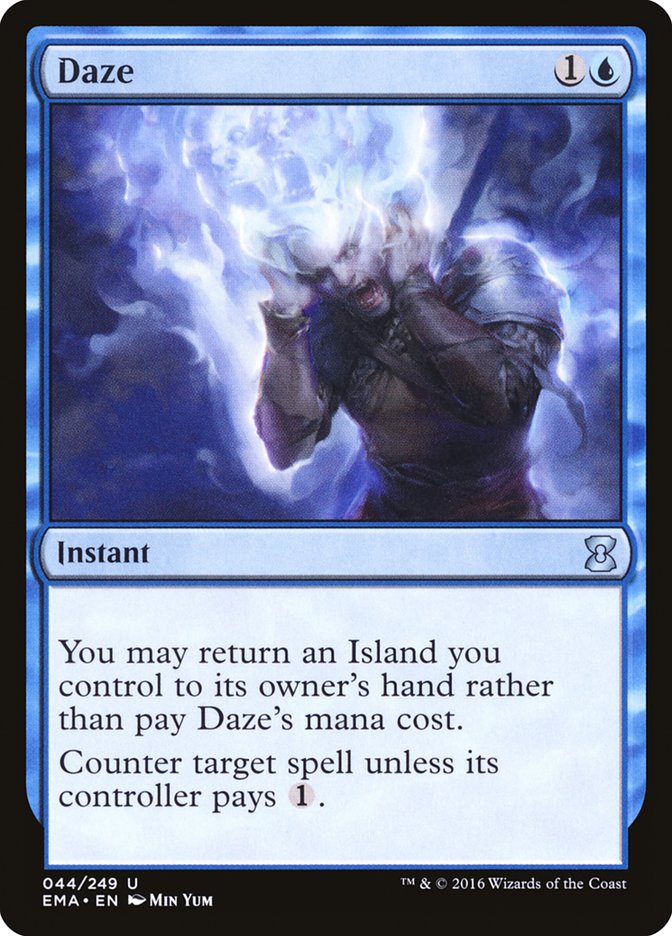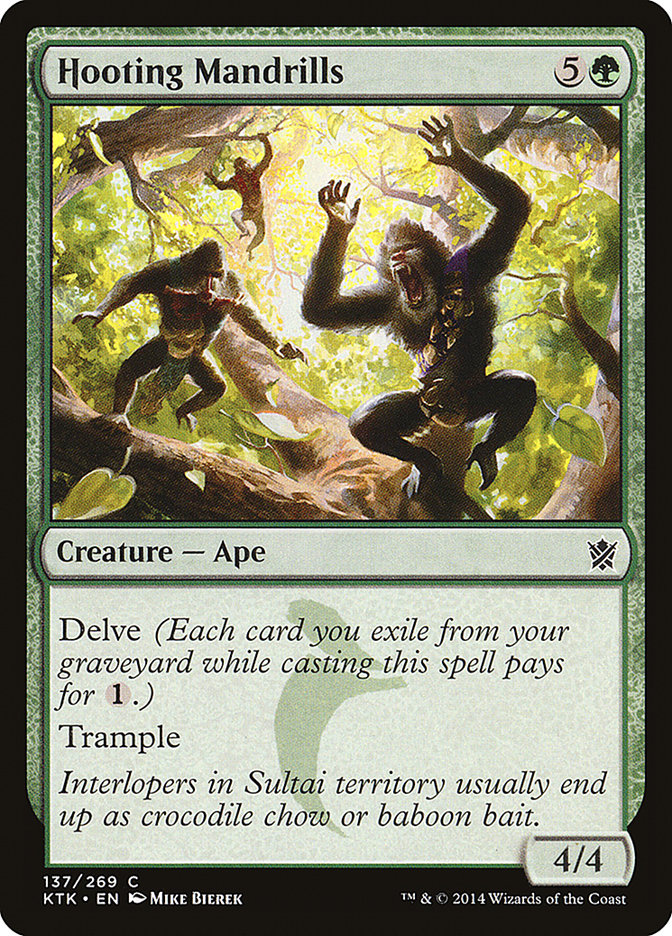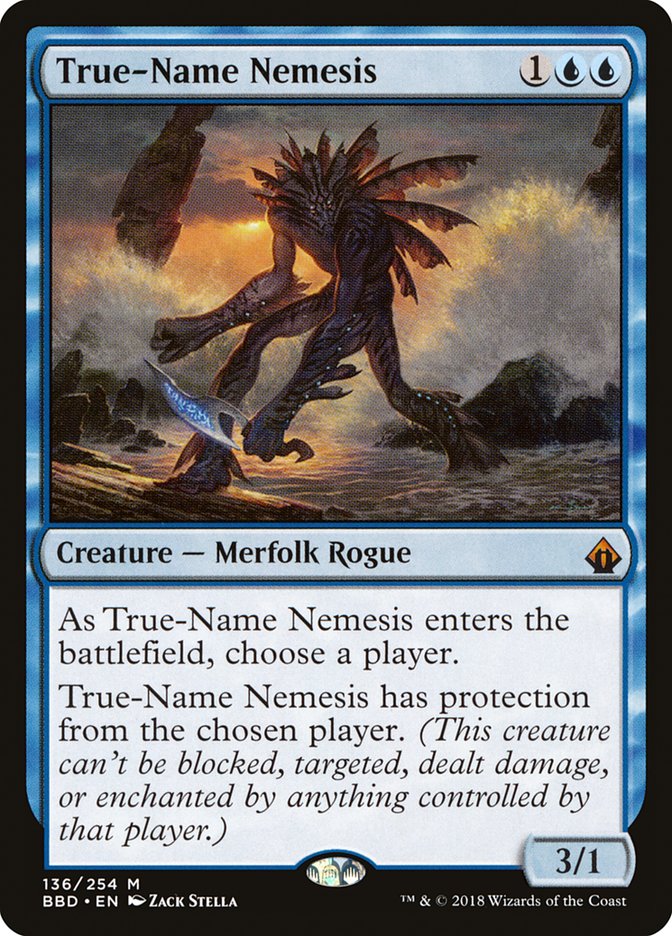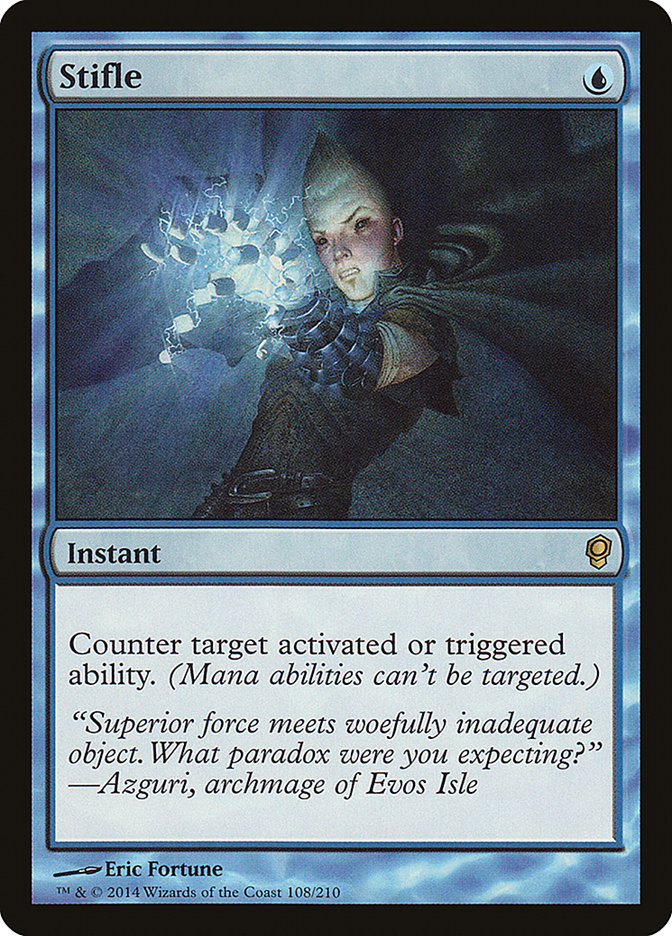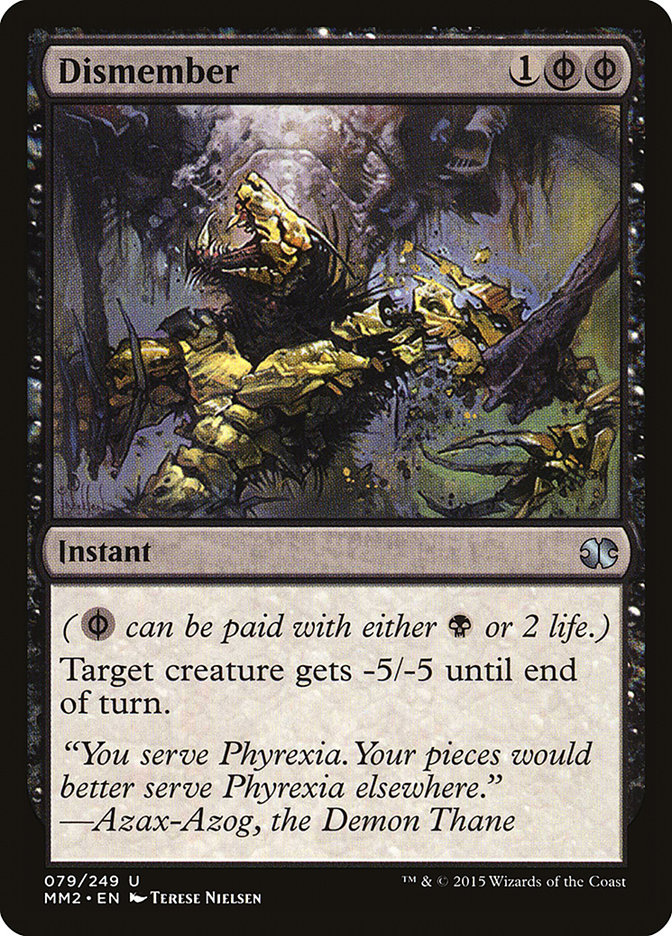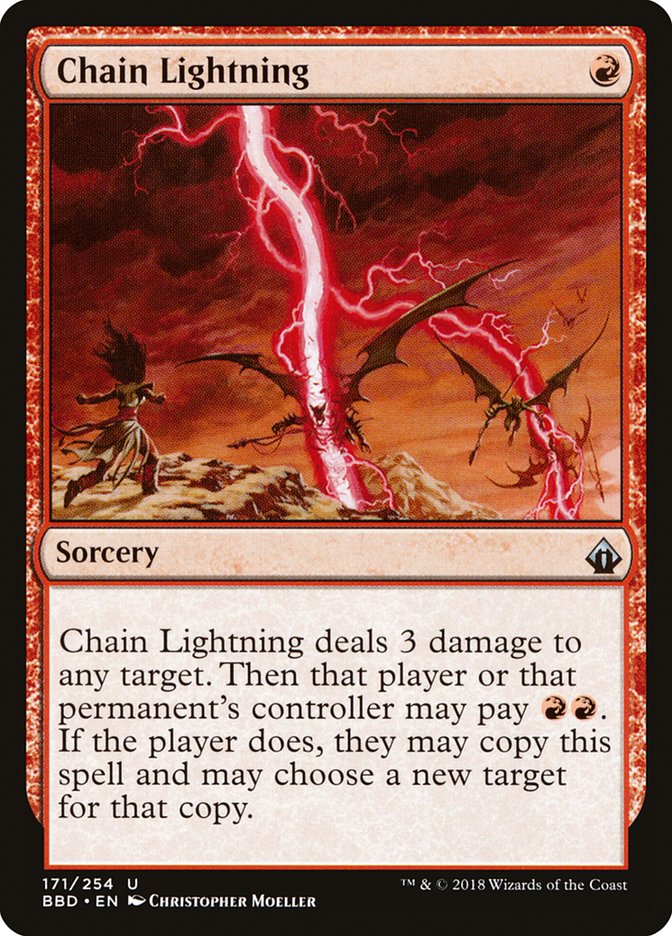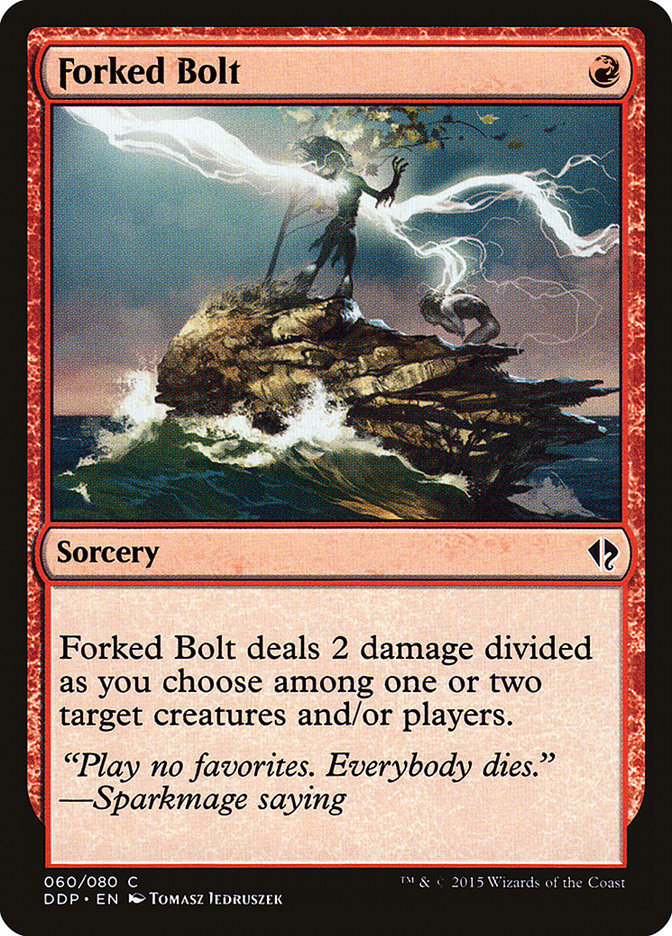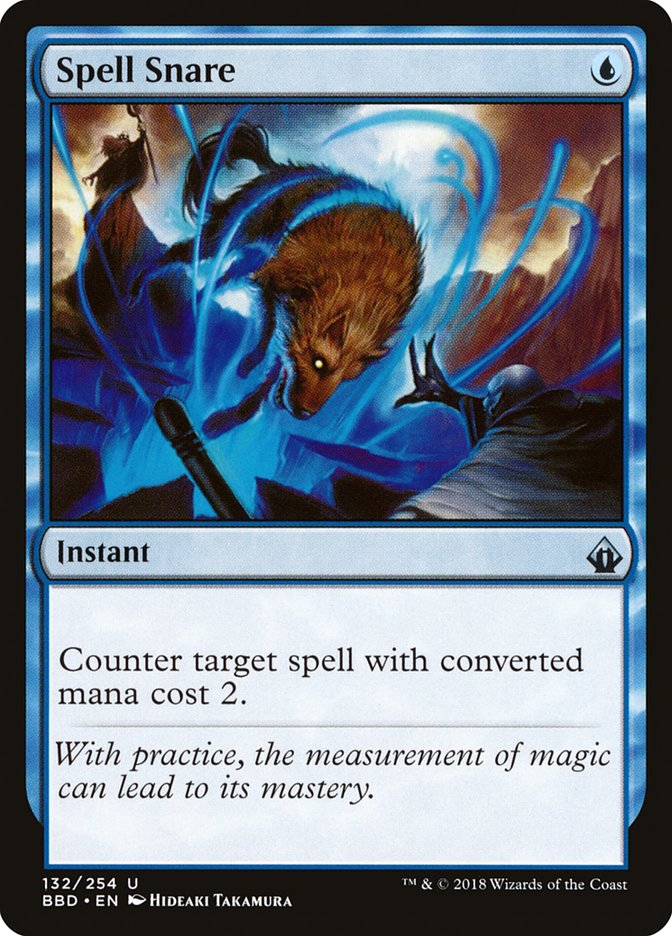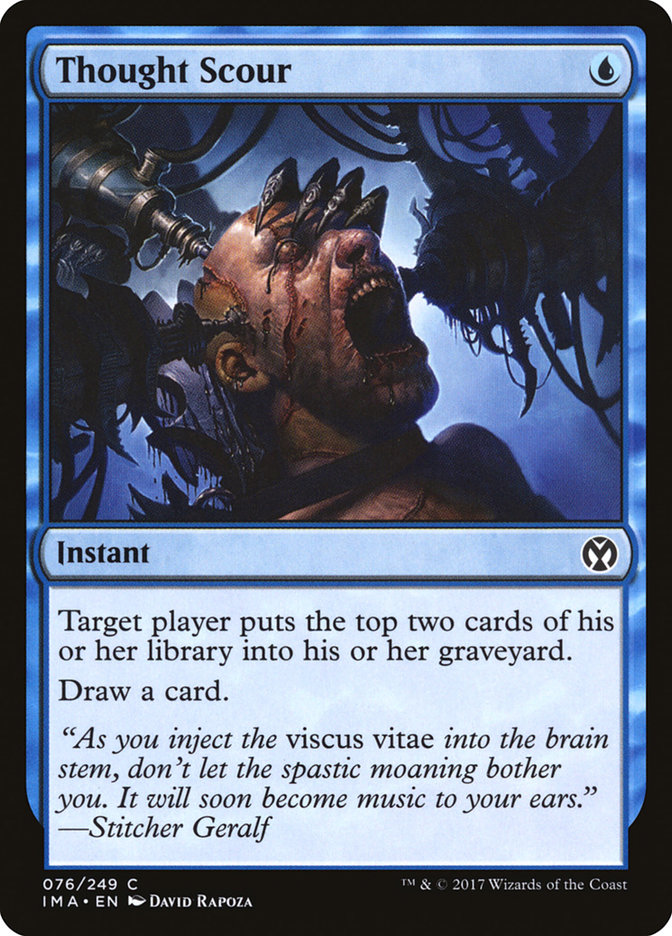I’ve been running hot with the Banned and Restricted List updates lately.
First, the fine folks at Wizards of the Coast free my Bloodbraid Elves in
Modern and then they lock away the scourge that was Deathrite Shaman? It
has been a good few months.
I’m not a vindictive person. A deck can beat me time after time despite my
best efforts to stop it and I’m not going to start calling for it to be
banned. I’ll try something else, or maybe play it myself. No, I’m happy
about the Deathrite Shaman ban for a different reason: it was effectively
an unban of my all-time favorite Legacy deck, Temur Delver.
Believe it or not, I actually Top 8’d with
Tarmogoyf alongside Nimble Mongoose long before I ever paired it with
Thoughtseize. That’s right, before I was Jundine, I was RUGdine.
Admittedly, that one never really caught on. Regardless, it’s safe to say
I’m very excited to get the band back together and attack with three-power
one drops at #SCGWOR.
The Temur Dark Ages
It’s not that Temur Delver was actually unplayable during the reign of
Deathrite Shaman. Some diehards, myself included, still
showed up to tournaments ready to Stifle everybody else out of the
tournament. When you show up to a Magic tournament you can register any 75
cards you want, no matter how poorly positioned. At least, as long as it’s
an individual tournament. I’ve been unable to find teammates willing to let
their success ride or die on the wings of the Mongoose for Team Constructed
Opens. Nonetheless, sometimes the deck would even win a little:
Creatures (10)
Lands (18)
Spells (32)

The problem with Temur Delver was two-fold. First, Grixis Delver was just
an overall better deck. It had better matchups more-or-less across the
board and was generally thought to be ahead in the head-to-head, although
it was somewhat close. If you wanted to be the disruptive aggro deck, it
was hard to justify not playing Grixis Delver. Second, the card Deathrite
Shaman itself was a huge problem for the Temur Delver strategy, and its
hold on the format went far deeper than merely Grixis Delver.
Ask ten Temur Delver players to describe the deck to you and you’re going
to get ten different answers, but the importance of mana denial to the
strategy will be a recurring theme. Mana creatures in general are bad news
for Temur’s mana denial. Not only are they additional mana sources to deal
with, they are mana sources that circumvent the one land per turn rule.
Temur can answer mana creatures, Temur can answer lands. Doing both in a
single turn cycle can be a big ask, giving the enemy time to leverage their
mana advantage, something that Temur desperately does not want to happen.
Deathrite Shaman in specific was even worse. We joke about Deathrite being
a one-mana planeswalker a lot, but the truth is that Deathrite’s role as
both a threat and a mana source meant that decks with the Shaman tended to
count it as a spell and not a land in deck construction, giving them an
overall higher density of mana sources. All this, and we haven’t even
talked about the great evil of Deathrite Shaman yet: the spreading of mana
creatures to black decks. Mana creatures were always a pain, but they used
to be an isolated pain. Post Deathrite, they were everywhere.
These are a little more restricted in their play.
I used to be very wrong on this issue. I argued that yes, Deathrite Shaman
had to die, but what didn’t? There’s not a lot of creatures in Legacy that
Temur Delver can just win through; answering the enemy’s early plays was
always part of the Temur Delver game plan. What I missed was that the
difference between Deathrite Shaman and those other early plays is that
Deathrite Shaman had to be dealt with immediately, while other things could
sit for a few turns and still be beatable.
Delver of Secrets, for instance, could be safely left alone while you
handled other matters. You can afford to take six or nine from an Insectile
Aberration if it puts you in control of the tempo of the game. Leave a
Deathrite Shaman alone, however, and that tempo will not be yours to wield.
So yes, sometimes you had the Lightning Bolt to answer Shaman immediately,
and everything was fine. The rest of the time, you were fighting from
behind from the very beginning, and Temur Delver does not like to
play from behind.
I could go on. I could talk about how Deathrite Shaman was a mana creature
in decks with much less air than mana creature decks usually have,
or about how it exiling cards from your graveyard was a small but nonzero
problem. But I don’t need to. Deathrite Shaman’s gone, and we don’t have to
worry about that anymore.
Hopefully what I have talked about has been enough to convince you that
Deathrite Shaman the card was a big enough problem for Temur Delver to warp
around handling it. It’s now up to us to unwarp the deck for this new
Legacy format. Last week’s build may as well be last year’s build for how
relevant it is to us today.
The Fear
With Grixis Delver suddenly without two of its most powerful spells, I
expect many of you reading this article to be former Grixis Delver pilots
looking to jump ship to another Delver deck. Welcome, you’ve made a great
choice and I hope you have a great time attacking with the Mongooses.
Before we dive in to the many questions about how to build the deck for
this brave new Legacy world we find ourselves in, there’s something you
need to understand: The Fear.
Grixis Delver and Temur Delver, despite both being Delver decks, are very
different. You need to understand this before we go any further, to
internalize it deep in your consciousness. If you’re looking to recapture
the Grixis Delver Magic of being miles ahead of your opponent on every
axis, you need to look elsewhere. There are no easy games with Temur
Delver.
Actually, that’s not quite true. There are easy games with Temur:
the ones where you Stifle / Wasteland your opponent back to turn zero and
run them out of lands for most of the game. Despite what some Temur
naysayers might have you believe, these games do not happen very often. The
rest of the time, you’re going to be sweating every one of your opponent’s
draw steps.
Temur Delver is the purest tempo deck I’ve ever had the pleasure of
playing. Your aim is to get slightly ahead of your opponent in development,
and then use every resource at your disposal to stay ahead long enough to
win the game. Every game is a race, but instead of being between your
damage output and your opponent’s damage output, it’s between your ability
to end the game and your opponent’s ability to resolve their unbeatable
spells. And trust me, there’s a lot of spells that Temur can never
beat.

Of course, there’s Magic player hyperbole going on here. It is technically
possible for you to win games in which these spells resolve, if you’re far
enough ahead at the time. But if any of these stick in a game at parity,
the writing is on the wall. The good news is that your primary plan is to
greatly delay the turn on which these cards resolve.
Still, the fact remains that given enough time, every deck in Legacy will
eventually over power you. You’ll win many games where your opponent still
has cards in hand, and each of those cards will terrify you. There’s no
deck I’ve ever won so much with while simultaneously feeling like I was
losing every game I played.
Embracing Temur Delver is embracing life on the edge. If having zero
answers in the 75 to a resolved True-Name Nemesis scares you, play a
different deck. Playing Temur requires a totally different mindset and
playstyle than Grixis. I’ve had a lot of trouble switching between the two
decks because their different playstyles require you to play the same cards
in totally different ways.
Temur Delver makes you play some aggressive Force of Wills. No
lie, I’m not going to miss thinking about what to do if my opponent plays a
turn one Deathrite Shaman every time my opening hand has a Force of Will.
The goal for Temur is to avoid parity, where Grixis was more concerned with
falling behind. Spots where your opponent Lightning Bolts your Delver of
Secrets are often Force and hope they don’t have a second Bolt spots for
Temur, whereas Grixis is far more likely to let it go and avoid the risk.
All the counter magic is like that, because Temur’s priorities on what to
stop with its disruption is far different than Grixis’s.
Where Grixis wanted to pick its spots carefully, win fights and gain an
advantage, Temur just wants to buy time. An awful exchange can often be
worth it if it buys one more attack with a Tarmogoyf or Insectile
Aberration. Tying up the opponent’s mana for a turn can be more important
than winning the counter fight. If you try to play Temur like you would
Grixis, you’re not going to be happy with your results.
Selecting your Threats
But enough of that. Before you can play the deck, you must build the deck.
Let’s figure out what we want our 75 to look like in this new era.
The biggest shifts that Temur Delver underwent during the Dark Ages all
involved the creature suite. It used to be easy: 4 Delver of Secrets, 4
Nimble Mongoose, 4 Tarmogoyf. Done. But as the deck began to fall out of
favor, those who stayed faithful undertook some desperate measures to keep
it playable. Here’s the six primary possibilities:

Some winnowing before we begin: maxing out on Delver of Secrets and Nimble
Mongoose is a given. That has essentially been a constant throughout, and
if you’re not interested in Delver and the Mongoose you should probably be
looking at a different deck. The number of threats in the deck has ranged
from ten to twelve, leaving us needing to select two to four more from the
remaining options.
Young Pyromancer can easily be removed from contention. Without Gitaxian
Probe as a zero-mana enabler, Young’s power level drops considerably.
Further, its play in Temur Delver has always been very fringe and the card
does not truly fit the Temur playstyle. I am very comfortable saying you
should not register Young Pyromancer in your Temur Delver deck.
Let me get my bias out in the air: I’ve never liked Hooting Mandrills in
Temur Delver. It has seen play, successful play, and I still just do not
care for it. For me it comes down to what I call the Ideal World Problem.
The idea behind Hooting Mandrills in Temur Delver is that you only ever
want one threat. You want one creature on the battlefield, attacking them
turn after turn while the rest of your resources are spent protecting that
threat and ensuring it gets to keep attacking. When this happens, Hooting
Mandrills and Nimble Mongoose don’t conflict. It doesn’t matter that
casting Mandrills takes you off threshold, because your game plan involves
winning with just one threat.
The Ideal World problem manifests in a lot of ways. Earlier, when I said I
used to think that Deathrite wasn’t a problem because you needed to remove
their early plays anyway, that was Ideal World thinking. Ideally, you have
the Lightning Bolt on turn one. Ideally, you always throw back your extra
threats with Brainstorm, never needing more than one. The real world is
never that clean.
Sometimes you draw four threats and can only reroll two of them. Sometimes
fixing your flood is the primary task of your Brainstorms, and sometimes
you don’t see a Brainstorm all game. Worse, sometimes you are forced into a
race and need a faster clock. Weird things happen in games of Magic, and
our plans only last until the first card is drawn.
Okay, now that I’ve got my hatred for Hooting Mandrills out in the open,
let’s talk about what it does have going for it. There’s two big
interactions that have made Mandrills playable in recent months: Fatal Push
and True-Name Nemesis. With the high popularity of black decks in the
Deathrite era, Fatal Push and its cousin Abrupt Decay became the Legacy
removal spells de jour. These spells kill Tarmogoyf, they don’t kill
Hooting Mandrills. With Miracles greatly reduced in the format, play of
Swords to Plowshares was at an all-time low. Against a lot of decks,
Hooting Mandrills may as well have shroud, since none of the removal
touched it anyway.
As for the True-Name Nemesis interaction: trample matters. Tarmogoyf can’t
effectively attack through True-Name Nemesis, Hooting Mandrills barely
notices that anything is in its way. This is an important interaction when
it comes up, but here’s the thing: with Deathrite Shaman banned, play of
Fatal Push, Abrupt Decay, and True-Name Nemesis is all going to go down.
Worse, with black’s stranglehold on the format past, it’s very likely that
play of Swords to Plowshares will rise. If there was ever a time for
Hooting Mandrills, I think it has passed.
So much about True-Name Nemesis is exactly what Temur Delver wants. A
threat that doesn’t need to be protected, that can’t be blocked, that
attacks for three every turn no matter what. It even pitches to Force of
Will in a pinch. The problem lies in the upper right corner: three mana is
just too slow for Temur against the unfair decks of the format. With Delver
having a decreased meta-share and combo looking to be the big winner of the
Deathrite ban, I want my True-Names in the sideboard.
That leaves Tarmogoyf, old faithful. Tarmogoyf may be the only choice left
after the elimination of the others, but this is no last pick scenario.
Tarmogoyf is exactly the threat you want in an unfair metagame, presenting
the fastest possible clock for two mana. Because Tarmogoyf is more
susceptible to removal than Hooting Mandrills or True-Name Nemesis, we want
to lean towards the high end of our threat count range and play all four
copies.
Other Important Questions:
There’s a little more to discuss yet, but first let’s look at the list I’ve
arrived at with another week of testing before #SCGWOR to go.
Creatures (12)
Lands (18)
Spells (30)

I don’t have an overarching theme for the rest of the important
deckbuilding questions to be considered, nor do I have definite answers for
you. Most of these depend greatly on how the format shapes up. Rather than
give you my best guess on what the right answer is, I’ll do that and talk
about how to evaluate the decision given the state of the metagame. Let’s
begin.
The question here is whether to play three or four Stifle. Four is the
stock answer, and Stifle is an important card to the Temur strategy, so
that makes sense. But Stifle is, by far, the hardest card in the Temur deck
to play. Drawing two copies can be extremely hard to leverage, and if
you’re new to the deck I highly recommend cutting the fourth to minimize
the number of times you do so. If you scroll up to where I linked my 2014
Top 8 with Temur, you’ll only see three copies, expressly because I did not
trust myself to play the fourth.
In metagames that are hostile to Stifle, drawing two copies can be a death
knell no matter how experienced you are. I’m somewhat worried that the
heralded return of Temur will make everyone prepare for Stifle. For that
reason, I’m considering going to three, but plan on making the final call
closer to the event.
Next up, the question of what and how many removal spells to play besides
the mandatory four copies of Lightning Bolt. In the Deathrite Shaman era
the number was as high as three, making for seven total removal spells,
with Dismember being preferred. With the play of Gurmag Angler likely to
drop, Reality Smasher, Thought-Knot Seer, and Tarmogoyf are the reasons to
play Dismember over a burn spell. Playing the first still sounds
reasonable, but I’m not at all excited by the second.
Expecting a lot of unfair decks where removal isn’t great, I like relaxing
the total number of removal spells to six and could see going to five.
Chain Lightning as an additional Lightning Bolt to the face for reach is a
reasonable hedge against drawing removal spells in a creature-light
matchup. Forked Bolt is excellent if you anticipate a lot of Death and
Taxes and Elves, which is not where I’m at in my metagame predictions.
The real question here is how many Spell Snares you want to play. When
Spell Snare is good, it’s fantastic, but drawing it when it’s not is often
painful. Its best targets are Stoneforge Mystic, Tarmogoyf, a ton of things
out of Storm, a ton of things out of Burn, Snapcaster Mage, and Baleful
Strix. These are all things you very much want to counter, and Spell Snare
is great at doing so. I’ve settled on one but am very close to wanting the
second.
Spell Pierce fills in the rest of the slots in the deck. If you go down to
five removal spells, you gain an extra slot here, which you should probably
use on a Spell Snare. Same thing if you cut a Stifle. The fourth Spell
Pierce is too many, but two or three are both fine numbers. If you cut both
a Stifle and a removal spell, I would try this out:
A one-of Thought Scour is a reasonable way to turbo charge your Nimble
Mongooses. The card isn’t excellent, but the cost to play it isn’t very
high, and it’s serviceable. I wouldn’t go too heavy on it, as it dilutes
the power of your Brainstorms and Ponders and finding a window to spend the
one mana can sometimes be a large ask.
As for the sideboard, the best advice I can give you is the next seven
cards on my short list, in order:


Sideboarding with Temur Delver is more of an art than a science, and if you
don’t understand what a card is doing in the sideboard, don’t play it. How
to sideboard with Temur would be a long article in its own right, and I
can’t do it justice here. If you have any specific questions, I’ll be happy
to provide rules of thumb and guiding principles.
Happy Temuring!



